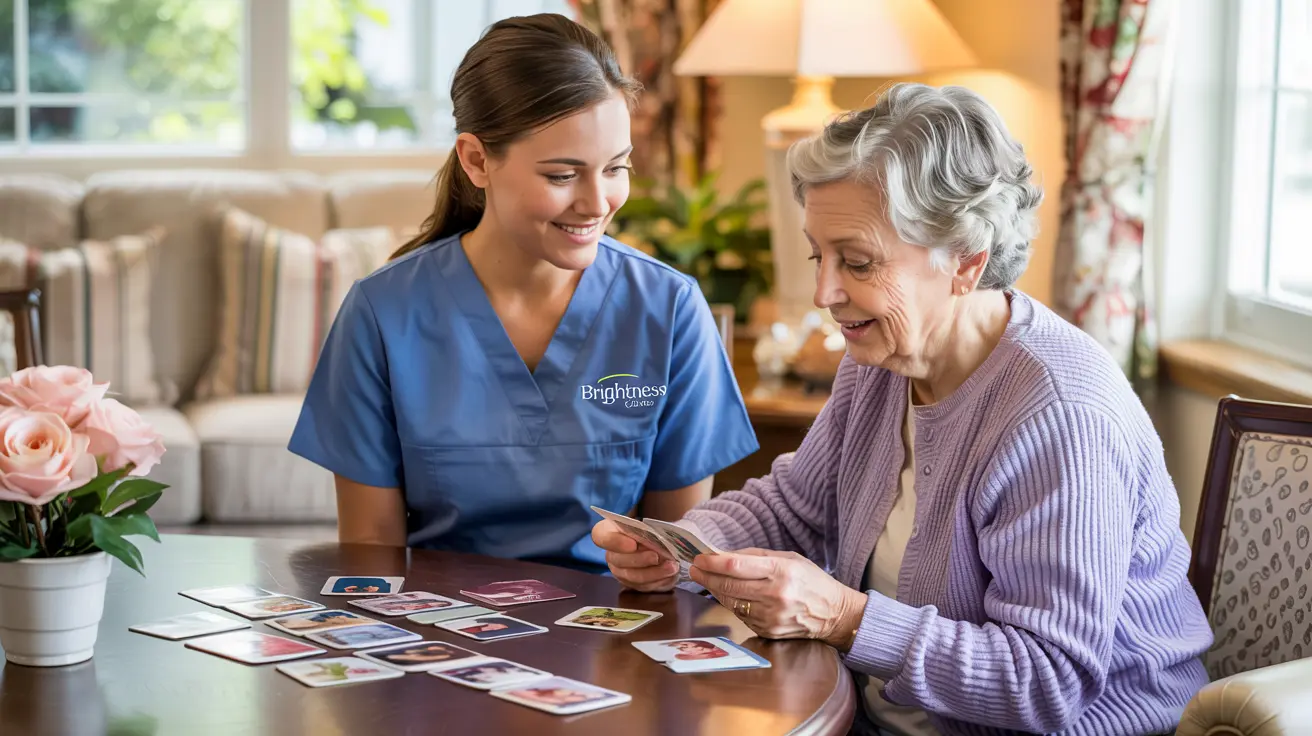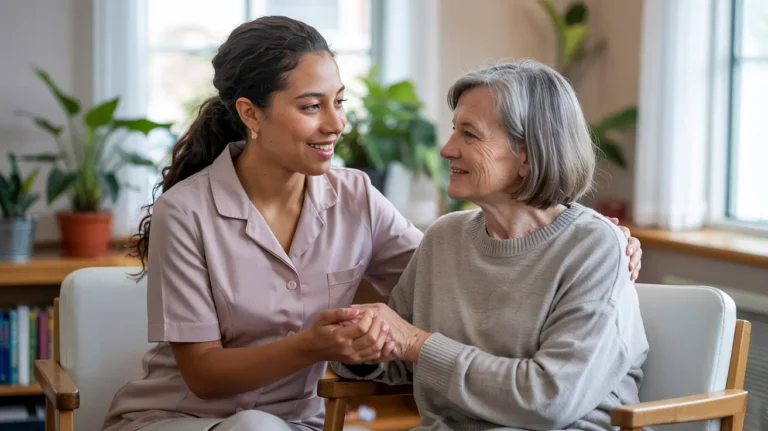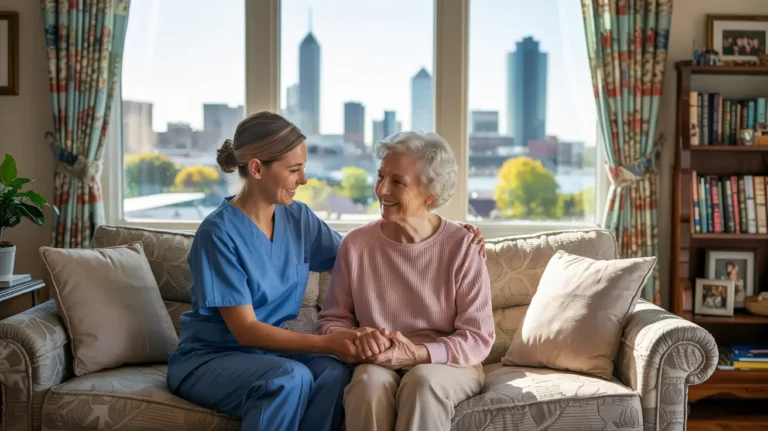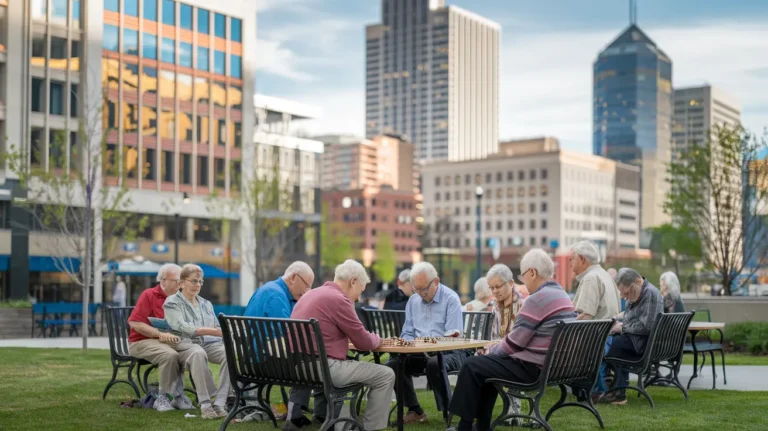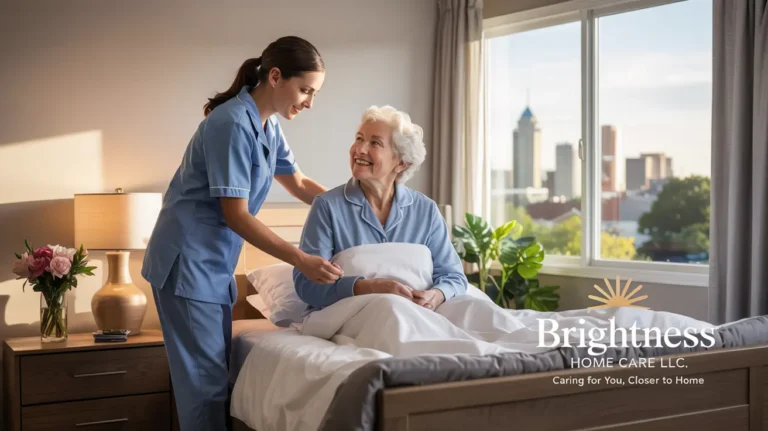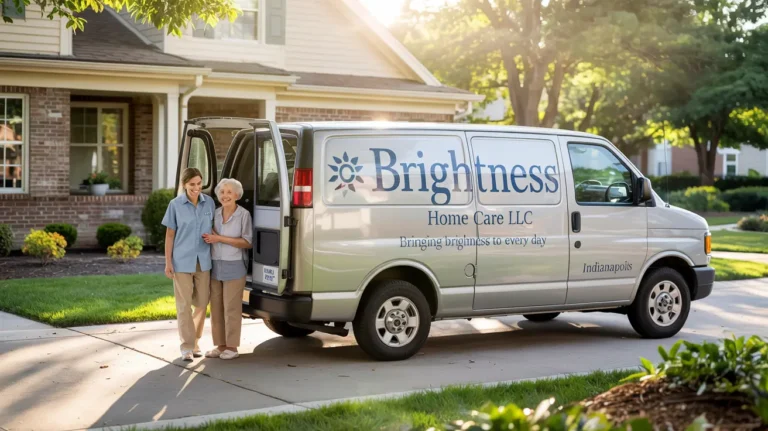Essential Memory Care Exercises for Seniors in Indianapolis
Did you know that regular memory exercises can slow cognitive decline by up to 50% in some seniors? I’ve seen it firsthand! When my uncle started showing early signs of memory loss, I panicked – we all did. But then we discovered the incredible power of consistent, targeted memory exercises. Here in Indianapolis, finding the right memory care activities can make all the difference between a senior who’s struggling and one who maintains their independence and joy. That’s why I’m so passionate about this topic! Brightness Home Care LLC has developed specialized approaches to memory care exercises that truly work for Indianapolis seniors. Trust me, I’ve tried all sorts of methods over the years (some total disasters!), and I’m excited to share what actually makes a difference. In this article, you’ll discover practical memory care exercises, learn how to implement them effectively, and understand why professional guidance can be such a game-changer for your loved one’s cognitive health.
Understanding Memory Care Needs for Indianapolis Seniors
Let’s get real about memory care for a minute. When my mom started putting her coffee cups in the freezer, I knew something was up. But I had no clue where to start! Memory challenges in seniors aren’t just about forgetting names – they often show up as confusion with daily tasks, repeating questions, or misplacing items in weird places.
I remember feeling totally overwhelmed trying to figure out what she needed. Should we do crosswords? Take walks? Play music? The options seemed endless and I wasn’t sure which would actually help.
What I’ve learned since then is that recognizing the signs early makes a huge difference. You might notice your loved one struggling to follow conversations, getting lost in familiar places, or having trouble remembering recent events. These aren’t just “senior moments” – they’re signals that some cognitive support could be beneficial.
Memory exercises aren’t meant to replace medical treatment – that’s a mistake I made early on! They work alongside medications and other therapies to provide comprehensive support. Think of them as mental workouts that complement what the doctor orders.
The thing that surprised me most was how personalized memory care needs to be. What works for my neighbor’s dad with mild memory issues might be frustrating or ineffective for someone with more advanced cognitive challenges. That’s why the team at Brightness Home Care in Indianapolis takes time to assess each senior’s unique abilities, interests, and challenges before creating a memory care plan.
When my family finally connected with professional memory care support, I was shocked at how they picked up on little details I’d missed. They noticed mom responded better to visual cues than verbal instructions, and they tailored activities specifically to her former career as a teacher. The difference was night and day!
Indianapolis seniors face unique challenges too – from navigating seasonal changes that can trigger confusion to maintaining social connections in a city that’s constantly evolving. Having someone who understands these local factors can make memory care more effective.
The most important thing I’ve learned? Don’t wait until there’s a crisis. Starting memory exercises early, even before there are significant signs of decline, can help maintain cognitive function longer. I wish I’d known that sooner! Memory care isn’t just about preventing decline – it’s about maintaining quality of life and dignity through every stage of aging.
Physical Exercises That Boost Cognitive Function
I never understood the connection between moving your body and keeping your mind sharp until I saw it happen! My dad, stubborn as they come, refused memory exercises but would walk around the block with me. After just a few weeks of daily walks, he started remembering neighbors’ names better. Mind blown!
Walking is seriously underrated as a brain booster. It increases blood flow to the brain, reduces stress, and even stimulates the growth of new brain cells. I’m not making this up! Science backs it up, and I’ve witnessed the difference. Just 20 minutes of walking three times a week can improve cognitive function in seniors with memory concerns.
But what about folks who can’t walk easily? That was my aunt’s situation after her hip surgery. We discovered seated marching exercises where she’d lift her knees while sitting safely in her armchair. She’d count each lift, sometimes reaching 100, which gave her both physical movement and a counting exercise for her mind. Two birds, one stone!
Coordination exercises are gold for brain health. Something as simple as alternating touching your nose and then reaching outward challenges both sides of the brain. I used to feel silly doing these with my mom, but we’d end up laughing, which is another brain booster! The trick is making it fun rather than feeling like therapy.
Chair yoga changed everything for my neighbor with Parkinson’s. The gentle stretching and breathing exercises helped him focus his thoughts. The “chair eagle” pose, where you cross your arms and legs while seated, really challenges the brain’s coordination centers. He’d get frustrated sometimes, but that mental challenge is exactly what builds new neural pathways!
Brightness Home Care caregivers in Indianapolis are trained in safe movement techniques for seniors with various mobility levels. I was impressed when their caregiver showed up with resistance bands and a set of small hand weights specifically sized for my mom’s strength level. They understood that physical exercise needs to be both safe AND challenging to benefit memory.
The secret sauce? Consistency and progression. Random exercise doesn’t help much – it’s the regular routine that rebuilds those mental pathways. And exercises need to get gradually more challenging as seniors improve. I tried keeping my dad on the same routine for months and saw his progress plateau until we started adding new elements.
Don’t forget about balance exercises! Standing on one foot while holding a counter (for safety, of course – learned that lesson the hard way!) forces the brain to coordinate multiple functions at once. Start with 10 seconds and work up from there. My uncle went from wobbling immediately to managing 30 seconds, and his overall alertness improved too.
The best part about physical exercises for memory care is that they address multiple needs at once – physical strength, fall prevention, AND cognitive health. Talk about efficient! Just remember to start slow and check with a doctor first. I rushed my mom into an exercise routine once and regretted it when her arthritis flared up. Lesson learned!
Brain Training Activities for Seniors with Memory Concerns
I’ve tried every brain game under the sun with my clients, and let me tell you – not all brain training is created equal! Some of those fancy computer programs promise the moon but deliver disappointment. What really works? Good old-fashioned word games that challenge different parts of the brain simultaneously.
Crossword puzzles were my dad’s favorite, but they frustrated my aunt to tears. Instead, she loved word searches because they were less pressured. The key is finding the sweet spot between challenging and overwhelming. When I worked with a gentleman who’d been a history teacher, we created custom word searches using historical terms he once taught – the recognition lit up his whole face!
Memory matching games aren’t just for kids! I made oversized matching cards for my mom when her vision started failing, and we’d play for hours. Start with just 6-8 pairs and increase as abilities allow. The brilliant thing about matching games is they work on short-term memory in a low-stress way. One client went from barely matching 4 pairs to confidently handling 15 pairs over a few months!
Jigsaw puzzles deserve a special shoutout. They exercise visual-spatial skills, problem-solving, and memory all at once. The trick is choosing the right difficulty level. I’ve made the mistake of bringing 1000-piece puzzles to someone with advanced memory issues – instant frustration! At Brightness Home Care in Indianapolis, caregivers often start with specially designed puzzles with just 12-36 large pieces, then gradually increase the challenge.
Storytelling exercises blow me away with their effectiveness. We’ll look at old photos and ask seniors to tell us what was happening when the picture was taken. Even clients with significant memory challenges often recall detailed stories from long ago. One woman who couldn’t remember breakfast could describe her wedding day 60 years prior in vivid detail! These reminiscence activities strengthen identity and emotional wellbeing alongside memory.
Number games provide amazing cognitive workouts. Simple addition games or even counting backward from 100 by 7s challenges working memory. I’ll never forget watching an 87-year-old woman with early dementia beat her adult grandchildren at Sudoku – they were shocked, but I wasn’t! Different parts of the brain maintain function at different rates.
The real magic happens when caregivers know how to facilitate these activities properly. It’s not just about putting a puzzle in front of someone – it’s about providing just enough help to keep frustration at bay while allowing for success. Brightness Home Care trains their Indianapolis caregivers specifically in this delicate balance.
I learned the hard way that timing matters enormously. My dad could tackle complex word games in the morning but would get frustrated with even simple matching by evening. That’s “sundowning” in action – cognitive abilities often fluctuate throughout the day. Professional caregivers know to schedule the most challenging brain activities during peak cognitive hours.
One last tip: celebrate every win, no matter how small! I’ve seen the dejection on seniors’ faces when they can’t remember things they once found easy. But when we cheer for completing four puzzle pieces instead of focusing on the unfinished parts, their confidence builds, making them more willing to keep exercising their brain.
Music and Art Therapy for Memory Enhancement
Music has this almost miraculous effect on memory – I’ve seen it with my own eyes! My grandmother couldn’t remember what she had for breakfast, but play “In the Mood” by Glenn Miller, and suddenly she’s telling detailed stories about USO dances during WWII. It’s like the music unlocks doors in the brain that seemed permanently closed.
I made the mistake once of choosing classical music for an elderly gentleman because I thought it would be “soothing.” Boy, was I wrong! He hated it. Turns out he was a jazz drummer in his youth, and when we switched to Count Basie, his whole demeanor changed. The lesson? Personal preference matters enormously when using music for memory care.
Creating personalized playlists has become one of my favorite techniques. One client’s daughter brought in a list of songs from her mother’s high school years, and we created a “Class of 1955” playlist. The first time we played it, this normally quiet woman started singing every word! Her caregiver from Brightness Home Care in Indianapolis now uses music sessions to spark conversations about those memories.
Rhythm exercises add another dimension to music therapy. Even something as simple as clapping or drumming on a table to a beat engages multiple areas of the brain simultaneously. I’ve done this with groups where we pass a rhythm around the circle, each person adding their own touch. The concentration on faces is intense – and beneficial!
Art projects have surprised me with their effectiveness for memory care. Something magical happens when you put a paintbrush in someone’s hand. One gentleman who rarely spoke would tell elaborate stories about his paintings. The visual creation seemed to bypass the verbal blocks in his brain.
Collage making became my go-to activity after seeing how it stimulated memory without the pressure of creating something from scratch. We’d cut out magazine pictures of familiar items from different decades, and seniors would arrange them while sharing memories each image triggered. The conversations that emerged were incredible windows into long-term memory storage.
Indianapolis has amazing seasonal themes we incorporate into art therapy. Creating fall leaf prints with actual leaves from local parks or making cardinal-themed projects (our state bird!) helps connect art activities to familiar cultural touchpoints. Brightness Home Care caregivers often bring in materials that reflect local traditions, making the activities even more meaningful.
One approach that flopped for me was complicated crafts with too many steps. I learned to break activities down into manageable parts. Instead of creating an entire painted birdhouse in one sitting, we might just paint the roof one day, enjoying the sensory experience of the colors and brush strokes without the pressure of completing the whole project.
Group vs. individual creative therapy presents different benefits. In groups, there’s the social stimulation and shared experience. Individually, activities can be perfectly tailored to ability level and preference. At Brightness Home Care, they balance both approaches depending on each senior’s needs and comfort level.
The most beautiful outcome I’ve witnessed is how art and music create communication bridges when words fail. A woman who could barely speak anymore could still sing “You Are My Sunshine” perfectly. Another client who struggled with words could express complex emotions through color choices in painting. These therapies offer dignity and self-expression even as verbal abilities decline.
Sensory Exercises for Deep Memory Connection
Smell is probably the most underrated sense when it comes to memory care, but let me tell you – it’s powerful stuff! I once brought a vanilla extract bottle to a session with a former baker who hadn’t spoken much in weeks. One sniff and she launched into a detailed explanation of her prize-winning cookie recipe! Our sense of smell connects directly to the brain’s memory and emotional centers in ways other senses don’t.
I’ve created what I call “aroma boxes” for several Indianapolis seniors – small collections of scents tied to their personal histories. For a gentleman who’d been a gardener, we included little bottles of soil, fresh-cut grass, and tomato vine scents. His daughter cried the first time he started describing his vegetable garden from 40 years ago after smelling these familiar scents.
Tactile exercises are another game-changer. I brought in different fabric swatches for a woman who had been a seamstress, and watching her fingers recognize velvet from cotton before her mind could name them was fascinating! The muscles remember what the mind sometimes forgets.
Texture sorting games provide both sensory stimulation and cognitive exercise. I’ll gather items with different textures – smooth stones, rough sandpaper, soft cotton balls – and ask seniors to group similar items while blindfolded. It sounds simple, but it activates dormant neural pathways and often triggers associated memories.
Food-based sensory activities require careful planning (especially with dietary restrictions), but they’re worth the effort! One of my favorite exercises involves identifying familiar spices by smell or taste. The joy on someone’s face when they correctly identify cinnamon or vanilla is priceless! Brightness Home Care caregivers in Indianapolis are trained to incorporate safe food-based sensory activities that respect each client’s dietary needs.
I learned the hard way to avoid overwhelming sensory experiences. My first attempt at a multi-sensory activity included loud music, strong scents, and textured objects all at once. Total disaster! Now I know to introduce sensory elements gradually, watching carefully for signs of overload or distress.
Temperature contrasts create interesting sensory experiences too. Something as simple as alternating warm and cool cloths on hands can increase sensory awareness. One gentleman with advanced memory issues would become more alert and engaged after this simple temperature exercise, making subsequent memory activities more effective.
Creating multi-sensory experiences that tell a cohesive story works amazingly well. For instance, we once recreated a beach experience for Indianapolis seniors who couldn’t travel – the sound of waves playing softly, feet in a shallow tub of sand, the smell of sunscreen, and tasting lemonade. The reminiscing that followed was incredibly detailed and emotionally positive.
The beauty of sensory exercises is how they bypass the thinking brain and tap directly into implicit memory – the kind that stays intact longer in people with cognitive decline. I’ve seen people who couldn’t follow a simple conversation light up with recognition when holding a tool they once used daily or smelling a fragrance from their past.
Don’t underestimate the power of weight and pressure sensations! Weighted blankets or even something as simple as kneading bread dough provides proprioceptive input that can be grounding and memory-triggering. A former construction worker who rarely engaged in activities would spend happy hours sorting nuts and bolts by size – the familiar weight and feel in his hands clearly comforting and stimulating.
Creating a Consistent Memory Care Exercise Routine
Consistency might sound boring, but it’s absolutely essential for memory care success! I learned this lesson the hard way when working with my father-in-law. We’d do intensive memory exercises during weekend visits, then wonder why we weren’t seeing progress. Duh! Memory pathways strengthen through regular, repeated use – not occasional workouts.
Establishing a routine doesn’t mean you need a rigid schedule that causes stress. I’ve found that anchoring memory exercises to existing daily activities works best. One family I worked with in Indianapolis added word games during breakfast and gentle physical exercises before the evening news – these “bookends” to the day created natural consistency without feeling forced.
The magic number seems to be 20-30 minutes of focused memory exercise, 2-3 times daily. Anything longer often leads to fatigue and frustration. I made that mistake early in my career, pushing for hour-long sessions that left everyone exhausted. Shorter, more frequent practice yields much better results!
Brightness Home Care caregivers use visual schedules that seniors can reference throughout the day. We learned that even clients with significant memory impairment respond well to routine when they can see what’s coming next. One gentleman would get anxious every afternoon until we created a simple picture schedule he could check – the predictability was comforting for him.
Family caregivers often struggle with consistency because, let’s face it, life gets crazy! I recommend starting with just one consistent daily memory exercise and building from there. I’ve seen families successfully incorporate simple memory games during dinner or cognitive exercises while folding laundry together. These “routine stacking” techniques make consistency more achievable.
Tracking progress motivates everyone to keep going! I created simple charts for families to note observations – not formal assessments that feel clinical, but quick notes about mood, engagement level, and any memories shared during activities. One family was ready to give up until they reviewed their notes and realized their mom was actually initiating conversations about past events much more frequently than before.
Adapting routines as cognitive abilities change is perhaps the trickiest part of memory care. I remember feeling devastated when exercises that had worked for months suddenly became too challenging for a client. The professional caregivers at Brightness Home Care excel at this delicate adjustment process – knowing when to simplify activities while maintaining the core routine that provides security.
Time of day makes a huge difference! Most seniors with memory concerns have sharper cognitive function in the morning, with gradual decline throughout the day. I schedule the most challenging mental exercises before noon whenever possible. One client could complete complex word puzzles at 10am but found the same puzzles impossible after 4pm.
Celebrating small wins keeps everyone motivated! When my aunt finally remembered her grandchildren’s names after weeks of photo recognition exercises, we had a little ice cream party. These celebrations reinforce the positive emotions associated with memory care activities, making everyone more likely to maintain consistency.
Weather patterns in Indianapolis can disrupt outdoor routines, so having indoor alternatives ready is crucial. I’ve created “rainy day memory kits” for families that include sensory items, simple games, and photo cards that can be used when planned outdoor memory walks get rained out. Flexibility within structure keeps routines sustainable long-term.
Social Engagement as Memory Care in Indianapolis
Indianapolis has some fantastic resources for seniors with memory concerns, though I found them mostly by accident! After fumbling around trying to create social opportunities for my mom, I stumbled upon a memory cafe at a local community center. What a revelation! Watching her chat with others facing similar challenges – without the pressure of hiding her memory lapses – literally brought tears to my eyes.
Social interaction isn’t just nice to have – it’s absolutely essential for brain health. Studies show that socially engaged seniors experience slower cognitive decline, but knowing this fact and creating those opportunities are two different challenges! Brightness Home Care in Indianapolis has developed specialized outings that balance social stimulation with the structure that memory-impaired seniors need.
I made a classic mistake with my uncle, assuming he couldn’t handle group activities anymore after his diagnosis. Boy, was I wrong! When we finally tried a seniors’ painting class at the Indianapolis Art Center, he thrived. The key was finding the right environment – one where helpers understood memory challenges and activities were appropriately paced.
Family involvement makes an enormous difference, but it needs to be the right kind. I’ve seen well-meaning relatives pepper seniors with rapid-fire questions about recent events, which often triggers anxiety rather than connection. Instead, shared activities with minimal pressure work wonders – looking through photo albums, simple card games, or even just folding laundry together while chatting.
Local resources in Indianapolis that have impressed me include the memory programs at The Social of Greenwood, the dementia-friendly concerts at Palladium, and several senior centers with specialized memory enhancement groups. Brightness Home Care maintains connections with these organizations to help clients access appropriate social opportunities.
Intergenerational programs offer unique benefits – I’ve witnessed remarkable moments when memory-impaired seniors interact with children. One gentleman who rarely spoke would become animated and engaged when kids from a nearby elementary school visited his senior community. Something about children’s natural acceptance and in-the-moment focus creates magical connections.
The pandemic taught us hard lessons about social isolation’s impact on memory. During lockdowns, I watched my neighbor’s cognitive abilities decline rapidly without her usual social routines. Now, Brightness Home Care has developed contingency plans to maintain social connections even when in-person gatherings aren’t possible, including facilitated video calls and window visits.
Pet therapy creates social connections of a different kind. One woman I worked with barely spoke to people but would chat endlessly to visiting therapy dogs! The Indianapolis Humane Society has a wonderful seniors program that brings gentle animals to visit seniors with memory concerns – the emotional engagement these visits trigger often lasts for hours afterward.
Finding the right balance between stimulation and overwhelm can be tricky. I once took a client to a busy community festival, thinking the excitement would be engaging. Instead, the noise and crowds triggered confusion and anxiety. I’ve learned that smaller, quieter gatherings with clear purposes work much better for most seniors with memory concerns.
Technology can support social connections when used appropriately. Video calls with distant family members can be wonderful, especially when structured around a shared activity rather than just conversation. One family I worked with in Indianapolis established a weekly “virtual baking session” where grandmother and grandchildren would make the same recipe together over video chat – the familiar activity provided natural conversation points and memory triggers.
Conclusion
Looking back at all these memory care exercises, I’m amazed at how far we’ve come in understanding what really works for seniors facing cognitive challenges. From physical movement to brain games, sensory experiences to social connections – each approach offers unique benefits that can truly enhance quality of life.
I’ve seen firsthand how the right memory care exercises can transform someone’s experience from confusion and frustration to moments of clarity and joy. The key is finding the right balance for each individual and creating consistent routines that feel supportive rather than demanding.
If you’re caring for a loved one with memory concerns in Indianapolis, remember that you don’t have to figure everything out alone! Professional guidance can make all the difference in creating an effective memory care plan. The dedicated team at Brightness Home Care LLC understands the unique challenges Indianapolis seniors face and has developed specialized approaches to memory enhancement that respect dignity while providing meaningful cognitive support.
Safety always comes first with memory exercises – never push activities that cause significant frustration or could lead to physical harm. Start small, celebrate progress, and adjust as needed. Your patience and persistence will make all the difference!
I’d love to hear about your experiences with memory care exercises! What activities have you found most helpful for your loved one? Share your stories in the comments below, or reach out to Brightness Home Care LLC at their Indianapolis location on West 38th Street for personalized guidance on memory care exercises that could benefit your family member. Together, we can support our Indianapolis seniors in maintaining their cognitive health and quality of life!

